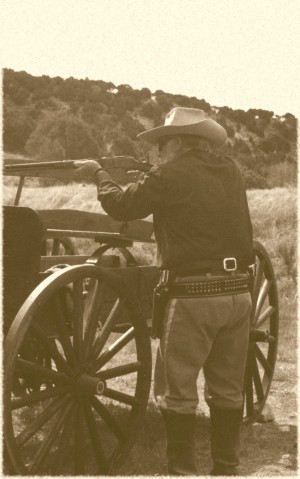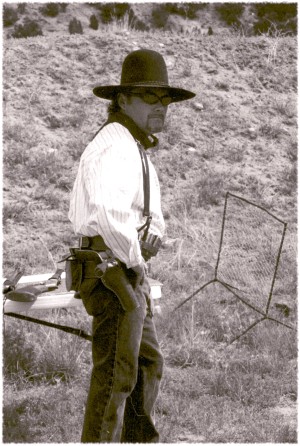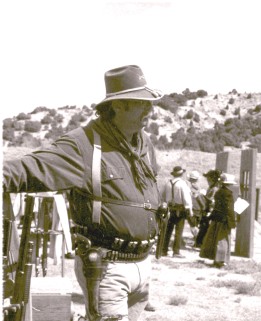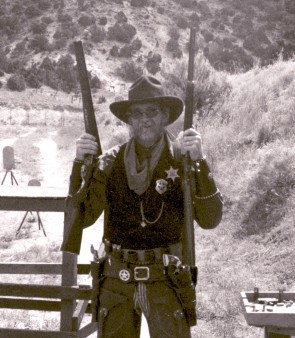![]()
Cowboy Action Shooting (CAS) is a shooting sport done in homage to America’s Wild West heritage. It is done with the type of guns used in the post Civil War period of western development and expansion. Most stages (shooting scenarios) use two revolvers, a rifle and a shotgun. Guns used must be representative of the period as defined by SASS rules. Cartridge or cap and ball, black powder or smokeless are all allowed.

Revolvers must be single action of a type and style (usually modern reproductions or copies) used on the frontier. Revolvers must be at least 32 caliber cartridge or 36 caliber cap and ball.
Rifles may be lever or slide action and must have an external hammer and shoot a “pistol caliber” cartridge. Rifles must be at least 25 caliber.
Shotguns may be slide or lever action with external hammers or side-by-side double barreled with or without external hammers, single or double trigger, without automatic ejectors. Shotguns must be at least 20 and no larger than 10 gauge.
What makes CAS unique (and extra fun) is the emphasis on costuming. You have to “dress up” to play this game. No modern dress items such as tennies, baseball hats, designer jeans, shorts and such are allowed. Although the name says “cowboy” many styles of dress are pursued by CAS shooters: cowboys, miners, sodbusters, townies, gamblers, saloon girls, soldiers and others are all seen at matches. Many CAS participants go to considerable lengths in their costuming but it is not required. A basic outfit could consist of blue jeans, work shirt, boots and hat.
Every CAS shooter has an “alias”. At a CAS match you are no longer Joe Jones or Suzie Smith. You are transformed and become “Big Timber” or “The Somedense Kid” or “Nurse Holliday” or “Thataway Gal” and you leave real life and your everyday troubles behind you.
Perhaps the most important aspect of CAS is what is called “the spirit of the game”. We play the game within the rules. We’re not looking for every little advantage or “loophole”. We look out for each other and help one another if problems arise. What it boils down to is that we are all friends.
![]()
WHO WE ARE
 The Northwest
Colorado Rangers are a group of cowboy action shooters located in the northwest
corner of Colorado in the town of Craig. We are affiliated with the Single
Action Shooting Society (SASS) and hold our matches at the Bears Ears
Sportsman Club’s Cedar Mountain Range. We held our first cowboy shooting match
in the spring of 1985 and have been going regularly since then. In 1997 we
began shooting monthly matches from April through September. We shoot a four
stage match on the fourth Saturday of each of those months.
The Northwest
Colorado Rangers are a group of cowboy action shooters located in the northwest
corner of Colorado in the town of Craig. We are affiliated with the Single
Action Shooting Society (SASS) and hold our matches at the Bears Ears
Sportsman Club’s Cedar Mountain Range. We held our first cowboy shooting match
in the spring of 1985 and have been going regularly since then. In 1997 we
began shooting monthly matches from April through September. We shoot a four
stage match on the fourth Saturday of each of those months.
We hold our annual match, “Where the Old West Stayed Young” over Memorial Day week-end each May. Side matches are shot on Saturday and the eight stage main match is shot on Sunday. In 2004 we had 100 shooters participating, a number of suttlers and a good turnout of spectators.
We are dedicated to having a good time and always do all that we can to make sure all our participants have fun shooting with us. Safety is critical to a fun shooting match and is the one aspect of cowboy action shooting where we “cut no slack”.
![]()
SAFETY
One of the most important aspects of Cowboy Action Shooting (CAS) is safety. We are shooting real guns with live ammunition at (mostly) steel targets. We are, therefore, extremely concerned that everyone at a match always acts safely.

Eye protection is a must for everyone at a match, shooters and spectators alike. At the Cedar Mountain Range we have loaner glasses if you forgot your own. Hearing protection is strongly recommended for everyone. Foam type ear plugs are adequate as we are not shooting “high powered” rifles with muzzle brakes and such. We have foam ear plugs available at the range if you need some.
Our matches are run with what is called a “cold range”. Although we are all packing iron (four guns per shooter) we keep all weapons unloaded until we are preparing to shoot a stage. The last thing we do before shooting is loading our guns. This is performed one at a time at the loading table under supervision. It’s not that we don’t trust one another it’s just that we have found that two sets of eyes and two minds on the job helps us stay safe. When we’re finished shooting the stage we move to the unloading table where guns are unloaded and shown empty before moving on.
When a shooter is “on the line” they are under the direct supervision of the range officer at all times. Again, this is not a matter of “trust” but of always being safe.
Because there are always other people around (range officer, score keepers, other shooters and spectators) we are always very careful about where we point our guns. Revolvers are kept holstered except while shooting a stage or at the loading and unloading tables. Long guns are kept cased or in carts with the actions open and carried to and from the cart with the muzzle straight up or down. No one wants to be looking down the barrel of someone else’s gun.
Safety always comes down to good sense. We always work together to be as safe as possible. We check each other not through a lack of trust but because we care—because we are friends.
